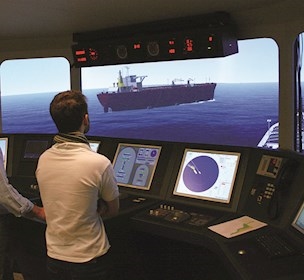Ship Handling
During the course, participants will have the possibility of testing and improving manoeuvering strategies.
Goals and objectives
The aim of the course is to provide shipmasters, deck officers and marine pilots with further knowledge of how to safely and efficiently handle larger vessels under influence of various met-ocean conditions (wind, waves and current) and in the port. Furthermore, the course aims to enhance pilot skills through practical exercises in the simulator in normal as well as in emergency conditions (loss of propulsion, thrusters etc.). The participants will thereby get an insight into and know-how of the capabilities and limitations in manoeuvering the specific vessel.
During the course, participants will have the possibility of testing and improving manoeuvering strategies. Moreover, they will become familiar with, and get a thorough understanding of, physical elements influencing the manoeuvering of the vessel. The objective of the lessons is also to give an insight into the use and manoeuvering of tugs.
Course description
The course focuses on manoeuverability and operational limits of existing or new ships. The simulator exercises ensure the best guideline for a real-life experience by changing and increasing environmental factors, such as wind and current, until the operational limits for harbour manoeuvres are met.
The course consists of theoretical lectures, simulator exercises and debriefings with the use of sophisticated replay tools. The exercises are normally prepared in advance on the basis of input from the client. Moreover, the course content and training exercises can be altered based on the input and knowledge level of the participating officers.
Gains
After completing the course, the participants will have a thorough knowledge within:
- Bernoulli, pivot point, propulsion, rudders, and bow and stern thrusters
- Constant Rate of Turn techniques
- Anchoring, wind and current
- Hydrodynamic effects: bank effect, ship-ship interaction, squat and shallow water
- Further tug and emergency operations
Please note that the subjects and the course structure will be amended during the course in order to suit the requirements and skills of the participants.
An updated and motivated crew improves efficiency at sea
The course contributes to increased safety and efficiency on board. A well-trained, professional and motivated crew that is continuously updated on manoeuvring theory as well as handling of specific ships under normal and extreme conditions will most likely reduce the incident and accident rate and enhance efficiency.
References: STCW including 2010 Manila amendments, 2017 edition. Table A-II/1 and A-II/2.


